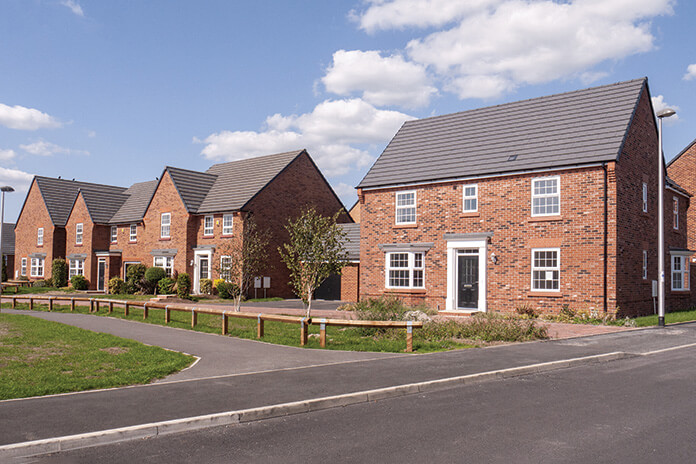Property Pipeline: Three years of progress
Turbo-charge your property business with a SSAS
Goal setting for 2021
Property market still breaking records
November saw the highest rise in house prices in nearly six years – despite the rest of the economy suffering from various Covid-19 lockdowns.
This was the headline figure in the mortgage lender Nationwide’s latest House Price Index, published towards the end of November. It recorded the property rise as 6.5% year-on-year, bringing the average cost of property in England and Wales to £229,721 – that’s an increase of £14,000. The monthly jump from October to November was 0.9% (or £1,895).
Mortgage lending highest in 13 years
But it’s not only house valuations that are up; mortgage approvals are higher than they have been in 13 years too, according to the Bank of England. Their most recent figures, revealed at the end of October, showed that there were a total of 91,454 mortgage approvals in September – the highest since 2007.
This has astounded many economists who had predicted the surge in interest and applications would have declined by this point in the year. However, there is no doubt the extension of the furlough scheme, together with Chancellor Rishi Sunak’s July announcement of a Stamp Duty Holiday, has helped maintain the buying momentum. Very low interest rates are also having an effect.
One economist, Samuel Tombs, attributed much of the property market boom to: “A relatively narrow cohort of well-off households, who already own their homes with little debt.” He said they had then managed to augment their savings by working from home thus saving on commuting costs.
Tombs is referring to the trend to move from cities and town centres to areas offering more greenery, countryside and space. Families, in particular, were keen to “upsize” to homes with more bedrooms and a garden – properties that are inevitably further out in the suburbs or in villages.
This is reinforced by another Nationwide survey that showed almost one third of those questioned were thinking of moving because they wanted more outdoor space. Around one quarter of people said they found city life too noisy and fast. This has resulted in property within national park boundaries costing 20% more than similar sized properties outside park boundaries.
Could the Stamp Duty Holiday be extended?
In order to mitigate the gains made by the robust property market, Tombs said he could see the chancellor extending the Stamp Duty Holiday scheme beyond the end of March. He also suggested that another speculated mortgage guarantee scheme could have an equally positive effect on the property market.
The call for a Stamp Duty extension is gaining momentum amongst industry professionals. Certainly, it was echoed by Tom Scarborough, chief executive of Movewise. Referring to the fact there is a big backlog of house sales transactions still to go through, he said he was aware of “growing calls for the deadline to be extended”.
The Stamp Duty deadline panic has meant that both empty properties and those that aren’t in a chain have become very highly sought after by those buyers looking to move quickly and take advantage of the £15,000 saving for the first £500,000 of a property.
First-time buyers increasingly worse off
Meanwhile, first-time buyers are still being priced out of the market after finance lenders pulled 90% of low-deposit mortgage deals from the market. An increase in second-home ownership in villages and “greener” areas has also resulted in escalating house prices.
However, it may not all be doom and gloom for the younger generation looking to get on the property ladder. The buoyant housing market is having a positive effect on the construction sector, meaning more new builds are going up, which should help to rectify the shortage of supply. Of course, understandably this is also something that is attracting landlords keen to expand their existing property portfolios.
High street build-to-rent: Is it catering to tenant demand?

In October, John Lewis Partnership outlined its plans to expand its remit beyond retail to help generate new revenue streams as the high street continues to struggle. One of these avenues is investing in the build-to-rent (BTR) market. Its initial plans set out for 20 sites – with the first applications for builds in London being submitted in 2021.
As John Lewis targets sites either above or near to existing stores on the high street, data suggests renters are ditching city centre living in favour of homes in the suburbs and smaller towns. Which poses the question – is there really a case for BTR on the high street?
Remote working and green space
Around the same time John Lewis announced its plans, research from estate agents Hamptons International indicated a growing trend of renters moving out of London and looking to the suburbs. According to its findings, 63% of renters who moved to a bigger home chose to leave London to do so, with remote working and green space cited anecdotally as reasons why people wanted to move out of the city1.
And this trend isn’t just in London. Research also carried out by Hamptons found in September that villages and commuter towns were growing in popularity with 34% of renters demanding extra space in Q2, up from just 25% in the first three months of the year. The same research also found that the northwest came second on the list of areas where people were upsizing properties to get an extra room or a larger garden.
Some people may argue these trends will be short term. Influenced by the pandemic, we have all had to change the way we live and work, meaning we have new habits and new priorities. How long this continues post-pandemic only time will tell, but according to SpareRoom2, more than one in ten renters plan to leave London and never go back to city living after the pandemic.
When you add to this the appetite for remote working to continue after Covid-19, a YouGov poll3 found just 7% of respondents want to go back to the office. All the signs point towards the trend for renting in the suburbs and more rural areas becoming the norm.
The growing BTR market
It doesn’t come as a surprise that retailers are turning to BTR for new streams of revenue – after all, it’s a booming market. In Q3 of 2020, £1.43bn was invested in BTR with the overall value of the market now at £14bn4. For a developing market, it boasts impressive figures.
Councils, authorities and businesses are searching for solutions to resurrect the high street, but demand for inner-city rental properties is likely to be in tough competition with high-quality suburban BTR homes. In 2020, Wise Living has witnessed the demand first-hand for properties away from the hustle and bustle of populous city centres.
Even during the first lockdown, we launched the first of three schemes, The Old Brewery, located in the suburbs of Mansfield, Nottinghamshire, and it only took a matter of weeks before all the homes were snapped up – remotely. We have seen this on our other developments in Telford and Coventry, and we fully anticipate to see the same trend on the developments we are currently working on. These might only be a few examples, but they provide a real snapshot of the demand for quality, single-family rental homes in suburban areas.
The shift in demand from your “traditional” city centre blocks to suburban homes with gardens means more investors, developers and BTR providers are turning their attention to those areas, tapping into locations such as Wolverhampton, Rotherham and Boston. In the last 18 months, Wise Living has secured £60m of funding from ICG Longbow as well as a further £100m from Triple Point – indicating real appetite from investors, not just renters.
Future demand
No-one has a crystal ball to see exactly how demand might shift following the pandemic. Yet current rental trends show strong signs that city-centre living is on the back foot and moving out of the city for extra living space and access to green spaces with no need to live near the office is taking precedence.
As the high street continues to struggle it’s clear that different thinking is needed to help regenerate areas that have been such an important part of the way of life in the UK for so many years – whether BTR is the answer, it remains to be seen.
3 [w] https://www.insider.co.uk/news/uk-office-workers-want-continue-22979780
Facebook ads – Part two
Labour Calls for Property Market Shut Down
The Labour Party is urging the government to effectively close down the property market in England.
Labour leader Sir Keir Starmer yesterday said he wanted to put a halt to moving house, renting apartments and all property viewings by estate agents.
His reasoning rested on the closure of schools which, he said, made no sense when property viewings were still permitted and garden centres remained open. In fact, allowing both were adding to the government’s already mixed messaging and confusing the public even more, he insisted.
Property market should follow first lockdown’s example
Sir Starmer also highlighted that the COVID-19 infection rate was higher now, with more people in hospital today than in March to May. At that point, during the first lockdown, all property viewings were banned under lockdown restrictions. Instead viewings were conducted via recorded videos or agents livestreaming their own viewing via mobile phone.
He told BBC reporter Laura Kuenssberg: “We are in at least as serious, if not a more serious position than in March of last year, [and yet] we’ve got fewer restrictions in place.
“I think we are going to have to look in the next 24 hours or so, what are the other measures that could be put in place, and hear from the scientists as to which of those that they think are more effective, and then all pull together and support those measures if they’re needed because the numbers are still, as everybody knows, heading in the wrong direction.”
Some estate agents have agreed with Mr Starmer with at least one business in Kent halting all face-to-face viewings with staff and clients, citing ‘moral’ reasons.
Johnson admits tougher restrictions an option
Mr Starmer may yet get his way since even Prime Minister Boris Johnston admitted yesterday that tightening down of the rules – including halting property viewings – may still be necessary.
“We’re going to keep the rules under constant review, where we have to tighten them, we will,” he said. “Of course, if we feel things are not being properly observed, then we may have to do more.”
Many agents, surveyors and conveyancers are currently working overtime trying to get house transactions through in time to meet the Stamp Duty Holiday deadline on March 31. A sudden halt to the property market would effectively put an end to many of these sales immediately. Or, it could mean the deadline being extended. This had been ruled out by Chancellor Rishi Sunak prior to the Christmas lockdown.
The Government hasn’t confirmed any intention to tighten up rules and have dismissed the Labour Leader’s criticism of their handling of the pandemic, insisting they have always been ‘fast to act.’
However, guidance on the government’s website says that it “may become necessary to pause all home moves… for a short period of time to manage the spread of coronavirus.” It also provides information for tenants and letting agents.
Property Market Enjoys Best Christmas in a Decade
Gloomy predictions of a slowdown in the housing market towards the end of the year were completely blown out the water this week. Instead, the housing market enjoyed its busiest and best Christmas in more than a decade.
According to the Bank of England more than 100,000 households were given the go-head to go forth and buy property in November. At 104,969 mortgages, it was the largest number granted since summer 2007. It also exceeded predictions by more than 20,000.
Of course, the Stamp Duty Holiday had a huge impact, as did the desire for many city dwellers to move to a bigger house and greener surrounds, following lockdown and home working.
And as for 2021? The end of the Stamp Duty Holiday is, of course, expected to see a decline in the number of house purchases. And no wonder – from October to March this year, buyers could save up to £15,000 on a house purchase – an incentive for anyone who’d been planning to move house last year.
But more telling yet, will be the end of the furlough scheme in April. Thanks to the roll out of the vaccine, this is expected to be the last coronavirus ‘jobs rescue scheme.’ Unemployment figures are then expected to be rise and it’s this which is expected to have the biggest impact on the market all year.
The uncertainty of house prices
Meanwhile, one of the big lenders Nationwide, reported a 7.3% rise in house prices year-on-year in its final House Price Index of 2020.
But could 2021 be a different story in this respect? Well, not according to property portal Zoopla, which confidently predicts a 1% rise. Tell that to the Centre for Economics and Business Research (CEBR) though, which expects a 5% drop.
Brexit no longer a threat to property market
Even Brexit is no longer viewed by many as a big challenge to the property market after a last-minute deal was secured on Christmas Eve, making the economic future seem far less rocky.
Mortgage availability, together with low interest rates, is in the property market’s favour. Both of these are firmly in place at the moment, with more mortgage products appearing daily. There are even suggestions that the Bank of England base rate may go even lower, resulting in negative interest rate territory. The reason being that this would prompt more investment in the very much ailing UK economy. The Chancellor was facing around 2 trillion of a debt deficit at the last count.
New deal for first time buyers
Help to Buy has returned – but in a slightly different format. This time round first-time buyers will find a cap on New Build housing costs. Those properties eligible for the scheme will be capped at 1.5 times the average property price in the region.
Once again, the funding will be 20% of the cost of the property, increasing to 40% in London. But crucially, stringent quality controls have been promised, together with a guaranteed new home warranty prior to purchase. It should encourage more first-time buyers to invest. The fact remains though that the number of houses being built here in the UK remains woefully short of its target to meet a growing need.
2021 Changes to ‘Relief’ Bills Introduced During Pandemic
There will be no Stamp Duty Holiday extension next year, the UK government has announced.
Their statement, revealed just before Christmas, was in response to a nationwide petition urging the government to extend Stamp Duty relief past its current deadline of March 31, 2021. The petition, signed by those in the industry, was presented to parliament with more than 28,000 signatures.
The government responded to the demand by saying that the idea behind the abolishing of Stamp Relief in England and Northern Ireland for homes up to £500,000, was to introduce an immediate stimulus for the market.
Introduced in July, the Stamp Duty Holiday certainly did its job, sending the property market reeling at times. Demand for housing had already been high due to lockdown but the opportunity to save up to £15,000 on homes worth £500,000 was the final push many keen but undecided buyers needed to move.
First-time buyers only Stamp Duty Absentees
Only first-time buyers will continue to enjoy Stamp Duty relief for homes valued at up to £300,000, and 5% for anything after that up to £500,000 after the Holiday cut-off date.
The rates for those who are already home owners, are due to revert to 2% on properties priced £125,001 to £250,000, 5% on homes valued at £250,001 to £925,000 and 10% for property from £925,001 up to £1.5m.
Surcharges for second home owners and overseas buyers
Buy to let landlords and those who buy a second home will pay an additional 3% on top of the existing Stamp Duty rates. In Wales, following a new ruling this month, the additional levy for second homes valued at up to £180,000 is 4%. For homes worth £1.6m or more in Wales, the Land Transaction Tax (LTT) is 16%.
Overseas buyers can also expect to pay a Stamp Duty surcharge – of 2% – for any property they purchase in England and Northern Ireland.
Mortgage payment holidays to end March 31, 2021
The huge help for current homeowners who had lost their jobs or faced furlough in 2020, was the Mortgage Payment Holiday. This too will come to an end at the beginning of April, with no current plans to extend it.
Rental evictions postponement
Due to coronavirus anyone served a Section 21 (or other eviction notice) between 29 August 2020 to 31 March 2021, must have been given six months’ notice, by law. Less than this and the eviction hearing won’t go ahead. Only in serious breaches of Tenancy Agreements, such as anti-social behaviour and non-payment of rent for up to six months, will the six months’ notice rule be abandoned. The ruling applies to all property in all Tiers, not just the most severely restricted areas.
Bailiffs banned until January 11, 2021
Coronavirus measures mean no bailiff possession cases can take place in England and Wales until January 11, 2021. Again, this is regardless of Tier. Due to the fact that 14 day’s notice must be given of an eviction taking place, the first bailiffs visits won’t be until January 25 next year.
Reactivation notices needed for repossession
Tenants issued with a claim for property possession prior to August 2, 2020 must be sent a ‘reactivation notice’ by the landlord as well as the court. The landlord must outline whether the tenant has suffered a loss of income as a result of the pandemic, or whether they have been shielding etc. Failure to supply this info will mean the repossession hearing won’t go ahead.










